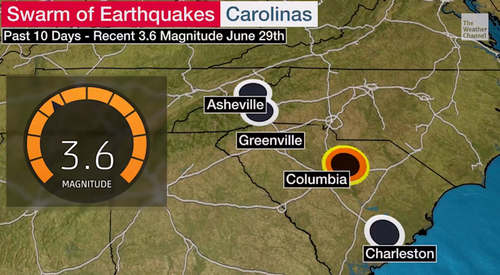Mystery Surrounds Intensifying ‘Earthquake Swarm’ Shaking South Carolina
A swarm of earthquakes rattled South Carolina and appeared to be getting more powerful. About 30 quakes have hit the state this year, and geologists are stumped about what’s causing “earthquake swarms” similar to those felt in Southern California.
Two earthquakes hit Elgin, South Carolina, on Wednesday. The first was a magnitude 3.5, and the second 3.6, according to data from the United States Geological Survey. A 3.4 magnitude earthquake hit the state days before, while a stronger 3.9 rattled parts of the Georgia-South Carolina border on June 18.
Wednesday’s earthquakes were the strongest since a magnitude of 4.1 struck the state in 2014.
South Carolina’s Emergency Management Division shared a video of Wendy Bohon, an earthquake geologist at the Incorporated Research Institutions for Seismology in Washington D.C., who said about 30 quakes struck in the year’s first half. She said the swarm of quakes is different than others because “there is no mainshock, or a larger earthquake that happens first then there are lots of smaller earthquakes that happen afterward … in this case, the swam of quakes are happening a few every week without a large shock.”
Thank you, Dr. Wendy Bohon.
Indeed, shift happens. https://t.co/pBHHALK9XP
— SCEMD (@SCEMD) June 29, 2022
The emergency agency also tweeted the state does have several fault systems and is “one of the most seismically active states on the East Coast.” However, some geologists are puzzled at why so many swarms are happening.
“Most earthquakes occur where the earth’s plates come together, and they’re the result of the tension and the stress that builds up as those plates are grinding and moving, slamming into each other. That’s not happening to us here on the East Coast.
“But there are ancient fault lines here from in the past when continents had slammed together … and they are still building up stress and strain but on a much, much slower time scale,” Bohon told the Weather Channel.
“If you can figure that out, you should go get your tux and pick up your Nobel Prize,” Thomas Pratt, regional coordinator of the Geological Survey’s earthquake hazard program, told The State newspaper. “The Eastern United States, in general, is not on a plate boundary, so it’s a mystery in the scientific community why in this exact location, in the middle of a plate, something would trigger this.”
Could the rumblings under ground suggest the next big quake is nearing? The last powerful quake to shake the state was a magnitude 7.3 in 1886.
Tyler Durden
Sat, 07/02/2022 – 20:00

